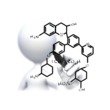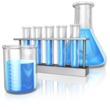 Guest Blogger: Patent Attorney David Stephenson
Guest Blogger: Patent Attorney David Stephenson
This is the first part in a series discussing issues facing the independent inventor in the field of biotechnology.
In the field of biotechnology, the USPTO often requires that a patent applicant provide experimental data to demonstrate that the invention works as claimed. To obtain a patent, inventors in the fields of biology and chemistry generally need to produce evidence, often in the form of experimental data, to demonstrate the usefulness of the invention.
Inventors in these fields, however, often don’t know exactly what type of evidence the patent office will require. Without the resources for university level research, independent inventors typically want to do the minimum amount of experimentation necessary to satisfy the patent office.
Great ideas in biotechnology are not limited to university academics and industry researchers. Independent inventors are creating drugs to combat disease, fuel for cars, nutritional supplements for better health, plants to increase crop yield and hundreds of other types of products that relate to biology and chemistry.
Independent inventors in biotechnology do exist and can be successful. Biological and chemical discovery and development, however, can present challenges to the independent inventor due to the high cost of research, government regulations and patent office standards.
To profit from an invention in biotechnology, and offset the cost of research and development, an inventor must seek patent protection. New chemical compounds or formulations with valuable properties, for example a drug, are typically difficult to discover but easy for a manufacturer to reproduce, making patent protection in biotechnology particularly important. Obtaining a patent on a biotech invention, however, can be problematic without the right strategy.
In order to develop a strategy to obtain patent protection, an inventor should have some understanding of patent law before beginning the inventive process. Section 101 of the Patent Act requires that an invention be “new and useful” to be eligible for patent protection. In biotechnology, unlike other fields, “useful” is often a more difficult standard to meet than “new.”
Unlike a new mechanical device, for example a mousetrap, the usefulness of a new biolo gical or chemical invention may not be readily apparent from drawings or demonstrations. Therefore, for inventions in biotechnology, the patent office often requires proof of usefulness, or utility, in the form of experiments.
gical or chemical invention may not be readily apparent from drawings or demonstrations. Therefore, for inventions in biotechnology, the patent office often requires proof of usefulness, or utility, in the form of experiments.
Inventors in the biological or chemical fields often ask:
“What experiments do I need to do?”
Each case has to be considered on its unique set of facts; however, the cases discussed below suggest that the more extensive and well-designed the experiments are, the better the chances for getting the patent. A quick history of the court decisions in this area, and how the law has changed over the past 50 years, can help an inventor formulate a plan for what needs to be done.
The first major case relating to experimental evidence and the utility requirement in biotechnology was Brenner v. Manson, 383 U.S. 519 (1966). In Brenner, the patent applicant claimed a new biochemical compound that was structurally similar to a compound known to inhibit cancer cell growth, and argued that this similarity was sufficient evidence of utility. The Supreme Court decided that the similarity did not mean the compound would necessarily be useful for treating cancer. The court held that an applicant must demonstrate the new compound had “specific and substantial utility in currently available form.”
Essentially, the court said that discovering a new compound that was probably useful was not enough for patentability.
The courts later addressed the type of experimental evidence necessary to show utility in biotechnology cases. The Court of Appeals for the Federal Circuit, just below the Supreme Court in jurisdiction over patent cases, addressed this issue in In re Brana, 51 F.3d 1560 (1995). The court held that experiments showing that an anti-tumor drug inhibited growth of cancerous mouse cells were sufficient for utility, even though the compound had not been tested with human cells.
The court stated that experiments performed by researchers other than the inventor with similar compounds could also, potentially, satisfy the utility requirement. So, in contrast to Brenner, the inventor in In re Brana was not necessarily required to perform experiments, at least not in human cells, to demonstrate utility.
In 2001, the patent office issued guidelines requiring inventors to demonstrate a “specific and substantial utility that is credible.” Under these guidelines, an inventor appeared to be required to disclose a compound currently available for use against an identified target, such as a type of cancer cell, and that there is a commercial value for the drug. The 2001 guidelines suggested a possible return to the strict utility standard of Brenner.
More recently, four cases, specifically involving biotechnology, have addressed the utility requirement in greater detail:
The first case related to whether an applicant who had not performed any experiments or cited any studies demonstrating the effectiveness of the claimed invention could meet the utility requirement. Rasmusson v. SmithKline Beecham Corp., 413 F.3d 1318 (Fed. Cir. 2005). The applicant claimed the use of finasteride in treating prostate cancer. Although no clear evidence was provided, the applicant argued that a scientist working in the field would have believed finasteride was effective in treating prostate cancer. The court held that the applicant needed to present evidence, preferably experimental proof, of the utility of the claimed invention.
The second case related to whether an applicant who had not performed any experiments could rely on outside studies to meet the utility requirement. In re ’318  Patent Infringement Litig., 583 F.3d 1317, 1324 (Fed. Cir. 2009).
Patent Infringement Litig., 583 F.3d 1317, 1324 (Fed. Cir. 2009).
The applicant claimed use of the drug galantamine for the treatment of Alzheimer’s disease. Six outside studies, not performed by the inventor, were referenced to support the applicant’s claim that galantamine was useful in treating Alzheimer’s disease. Two of these studies suggested that galantamine could cross the blood-brain barrier, and therefore reach target cells. Four of the studies showed that galantamine could affect memory in animal models.
The court was not convinced that these studies connected galantamine to a use in treating Alzheimer’s disease. The court said that human trials were not required to demonstrate utility, and that research conducted by someone other than the inventor could potentially be used to meet the utility requirement:
Typically, patent applications claiming new methods of treatment are supported by test results. But it is clear that testing need not be conducted by the inventor. In addition, human trials are not required for a therapeutic invention to be patentable…We have held that results from animal tests or in vitro experiments may be sufficient to satisfy the utility requirement.
A third case, decided by the same court a year after In re ‘318, seemingly lowered the bar set for utility in In re ‘318 and Rasmussen. Eli Lilly & Co. v. Actavis Elizabeth LLC related to a dispute over a patent for the use of Strattera to treat ADHD. No. 2010-1500 (Fed. Cir. July 29, 2010). The inventors had no clinical data supporting utility at the time the patent application was filed, although they did perform experiments after the filing of the application confirming utility (which the court found persuasive despite the general bar on adding new matter after filing).
The court stated that experimental data was not required at the time of filing because when an inventor asserts utility a presumption exists that the inventor is correct. This is known as the “Langer” test for utility. The “Langer” test presumes that utility should not be a bar to patentability if a person skilled in the art did not have a good reason to doubt the applicant’s claim to utility.
In Eli Lilly, the court believed that the outside studies put forth by the inventor demonstrating Strattera’s effect on brain chemistry were sufficient for the examiner to not have good reason to doubt Eli Lilly’s claim of utility.
In 2014, a Federal District Court (which is below the Federal Circuit in terms of authority on patent matters) addressed how much experimental evidence is required to meet the utility requirement. The plaintiff, Petito, had a patent for a nutritional composition, or nutraceutical, intended to relieve joint pain and was suing the defendants for infringement. Petito v. Puritan’s Pride, Inc., July 31, 2014, Engelmayer, P. The court had to decide whether Petito’s patent was valid.
The composition in question, commercially known as Osteocaps, was comprised of four compounds: [1] a glucosamine salt, [2] chondroitin sulfate, [3] collagen, and [4] sodium hyaluronate. These compounds were widely thought to be beneficial to joint health at the time of filing; however, Petito claimed that the synergistic effect of all four of the compounds led to an unexpectedly good result in treating patients with joint problems.
 The applicant had submitted experimental results claiming that four patients treated with the compound had greatly improved symptoms, beyond what would be expected if the four compounds in Osteocaps were combined. The court held that the patient data was insufficient. The court referred to In re ‘318 and Rasmusson in holding that the level of experimentation was insufficient:
The applicant had submitted experimental results claiming that four patients treated with the compound had greatly improved symptoms, beyond what would be expected if the four compounds in Osteocaps were combined. The court held that the patient data was insufficient. The court referred to In re ‘318 and Rasmusson in holding that the level of experimentation was insufficient:
The methodology is so lacking in any scientific rigor (e.g., the sample size is so small, there is no control group), and the description is so sparse (e.g., as to dosages, concentrations, frequency, other medications taken, and, most importantly, as to the number of patients who were treated with Osteocaps but whose symptoms did not improve), that the letter cannot qualify as an experiment within the meaning of In re ‘318 and Rasmusson…Considered together, In re ‘318 and Rasmusson instruct that a medical patent whose utility is not immediately apparent to a person of ordinary skill in the art demands a measure of proof.
Such proof typically requires experimental results but may, in the rare case, be accomplished by analytical reasoning.
Petito failed the “Langer” test. The patent was invalidated because the court did not agree that a person of ordinary skill in the art would believe the combination of the four compounds in Osteocaps would be any more effective for treating joint problems than the sum of the known effects for each of Osteocaps ingredients. Further, the experiments performed were insufficient for demonstrating a synergistic effect when the compounds were combined.
For the independent inventor, these cases provide insight into the level of evidence or experimentation required to meet the utility standard. The goal for the inventor in the field of biotechnology is to remove doubt as to utility whenever possible; whether through performing experiments, referencing other’s experimental data or sound scientific reasoning.
Applicant’s should be aware that evidence of utility acquired after filing for the patent MAY be considered new matter, in which case the evidence cannot be used to establish utility with respect to filing dates prior to acquisition of the evidence. Therefore, well-designed experiments performed prior to filing for a patent can be critical in meeting the utility standard and obtaining patent protection.
David Stephenson is a patent attorney at Kloss, Stenger and LoTempio in Buffalo, New York.
He received a B.S. in biochemistry from the University of Michigan, a J.D. from Emory University School of Law and a Ph.D. in biochemistry from the University of Rochester School of Medicine and Dentistry.








